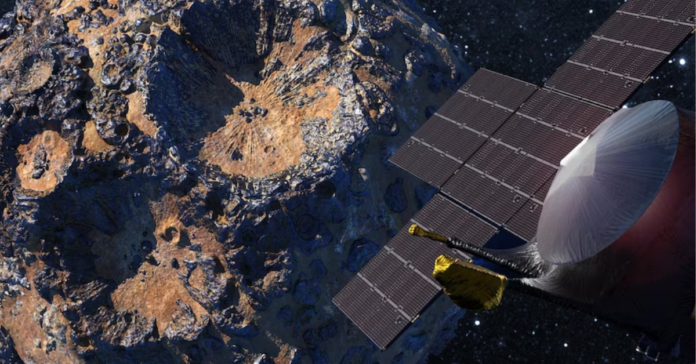Imagine an ancient remnant, drifting through the vastness of space, holding secrets that could unlock the mysteries of planetary information. This is no ordinary asteroid, Psyche- a metal-rich world unlike any other in our solar system. Imagine an ancient remnant, drifting through the vastness of space, holding secrets that could unlock the mysteries of planetary information. This is no ordinary asteroid, Psyche- a metal-rich world unlike any other in our solar system. Let’s delve into the story of ancient Psyche and explore why this mission could revolutionize our understanding of the early solar system and the very building blocks of our planet.
Discovery of Psyche 16:
Astronomer Annibale de Gasparis discovered the Psyche 16 on 17 March 1852. He named the asteroid Psyche after the ancient Greek goddess of the soul, who was also Eros’ lover. It was chosen for its mystery.The number 16 was used because it was the sixteenth minor planet discovered while exploring celestial bodies between Mars and Jupiter.
Observational Challenges :
When Psyche was discovered, scientists faced significant observational challenges due to the lack of technology compared to what exists today. In the 19th century telescopes were rudimentary and they lacked the basic imaging and resolution capabilities. That’s why it just appeared as small faint point of light in the night sky. After the development of more advanced instruments in the 20th and 21st centuries, scientists were able to study Psyche 16 in detail. NASA has announced detailed operations over Psyche 16, allowing the world to unveil its properties and mysteries as an M-type asteroid.
Physical Appearances & dimensions of Psyche 16:
- Psyche-16 is roughly shaped like a crushed potato, forming an ellipsoid rather than being perfectly spherical.
- The dimensions of Psyche 16 are approximately 279 kilometers (173 miles), making it the largest asteroid in the asteroid belt. Its surface exhibits a metallic gray or silver color due to its iron-nickel composition, and its high reflectivity makes it appear shiny compared to other asteroids. While typical asteroids are made of rocks, Psyche 16 consists of metals, with almost 95% of it composed of metals.Psyche takes four hours to rotate around its axis and about five Earth years to orbit the Sun, ranging from 235 million to 309 million miles. It’s 2.5 to 3.3 astronomical units.
Is Psyche 16 soggy?
Moreover, researchers found that Psyche 16 reflects little light and is less dense than expected for such a large body. To monitor such mysteries NASA along with a few universities in America has examined Psyche under the James Webspace Telescope.
Research in the American Astronomical Society’s Planetary Science journal stated that rare reflections on Psyche 16’s surface may result from hydroxyl ions. As hydroxyl ion is only one hydrogen less to form water. Among them, hydroxide when combined with water forms rust. These also give some clues of the presence of water on the surface of Psyche.
By using the James Webb Space Telescope, scientists are viewing Psyche 16 in more detail than normal light allows, as JWST uses infrared light to enhance visibility.
The composition of Psyche has led scientists to theorize it as an early planetary building block (remnant of planetesimal). However, uncertainties exist in the theory due to the presence of hydroxyl and water. Anicia Arredondo, a planetary physicist, said, “Endogenous hydration could suggest that Psyche is not the remnant core of a protoplanet.” He also proposed that Psyche might have originated beyond the “snow line” before traveling to its current location in the outer main belt.
It is unclear whether the water and hydroxyl are native to Psyche or were introduced by impacts from other celestial bodies. Further investigation is needed to determine the exact nature and origin of these compounds. For a detailed study of the asteroid, NASA launched a spacecraft named Psyche in October 2023. The main objectives include examining the surface, verifying ancient magnetic fields, and determining its composition. These will contribute to the understanding of the formation and evolution of terrestrial planets such as Earth.
Conclusion:
New questions arise about the composition and origin of asteroids after the latest discoveries. The presence of hydroxyl and rust on the surface is providing new theories and insights. The NASA mission is still in progress, so let’s wait and see what exciting news it brings and what strengths this billion-dollar metal ball holds.





[…] You may also like: […]
[…] You may also like: […]
[…] You may also like: […]